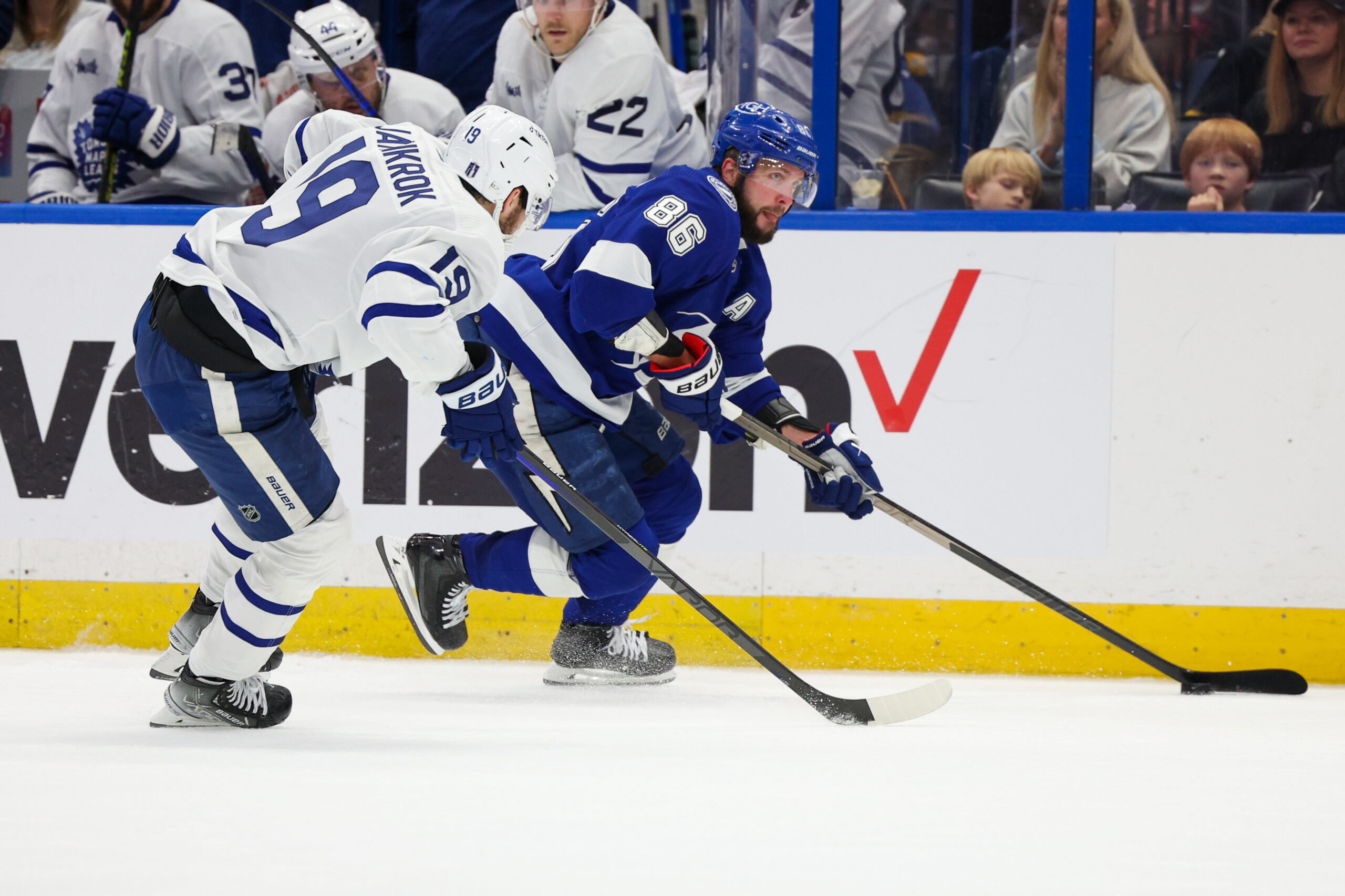Here at Last Word on Hockey, we look at the analytics concerning how the Tampa Bay Lightning moves the puck to transition from defence to offence.
In the last article, we covered offensive zone passing for the Lightning. The NHL only provides passing data through assists that result in goals. The league doesn’t recognize passes through the neutral zone in transition. However, the transition game is vital to the success of any hockey team. That’s why we hand-track microstats to cover these missed components and look at the bigger picture.
Transition Passing Analytics from the Tampa Bay Lightnings First Two Games
Exploring My Data
This project focuses specifically on the Tampa Bay Lightnings analytics. We at the LWOS Hockey Department are looking to track roughly 20 games throughout the regular season. We will analyze passing, zone entries, zone exits, and transition statistics. Let’s see how the Lightning is doing with transition passing through their first two games.
Transition Passing Glossary
The transition passing glossary has four categories.
Cross-Ice Passes: Transition
Cross-ice passes travel the width of the ice. They are the most difficult to complete out of the four categories in transition passing. Cross-ice passes involve the most risk but offer the highest reward. These passes change the angle of attack through transition and can open lanes on zone entries, leading to high-quality scoring chances.
Perimeter Passes: Transition
In studying analytics, we determine that perimeter passes in transition help advance the play efficiently and lead the offensive rush attack. Perimeter passes are most effective when the player skates at full speed up the wall. Receiving the puck in stride is difficult to defend. An example of a perimeter pass on a zone entry would be the centre lane man kicking the puck out to a flank. From there, the player receiving the puck on the perimeter can shoot, pass it back, or fire a cross-ice pass for a high-danger chance. While perimeter passes are the easiest to perform, they still hold extreme value.
Middle Lane Passes: Transition
The roster construction of the Lightning allows passes to the middle lane to work effectively. The centremen are usually the players receiving these passes in the middle of the ice. Brayden Point and Anthony Cirelli are two of the fastest players in the league. When the Lightning centremen swing low for support, the puck finds them with a burst of speed up the middle. From there, the centre lane man usually dishes the puck to the perimeter and drives the net to pull the rush defender with him. The net drive opens the ice for the trailing forwards on the zone entry.
Trailer Passes: Transition
In studying games, we determined that passing to the trailer in transition off a zone entry is the least commonly completed pass. The trailer is either the third or fourth man on the zone entry. The Lightning typically enters the zone in sync, with all three players horizontally in line on the entry. Then, the centre lane drives the net. If the puck moves cross-ice, it is a flat pass with no angle. The fourth man in is the defenceman who joined the rush late. In the modern NHL, we are seeing less stay at home defencemen. The defence must get involved in the offensive attack to generate offence.
The Results
Cross-Ice Leaders
Nikita Kucherov leads the team in cross-ice transition passes at even strength with two. Kucherov receives pucks off the zone entry and looks for that flat pass to the third man on the attack. His art of passing and deception is second to none in the league. Many other Lightning players completed a single cross-ice pass, including some names not listed below.
Kucherov: 2
Point: 1
Cirelli: 1
Hagel: 1
Hedman: 1
Sergachev: 1
Perimeter Leaders
Kucherov finds himself at the top of the leaderboard again. He always advances the puck forward through the neutral zone. On the zone entry, he sometimes cuts to the middle of the ice and switches lanes to create confusion. Then, he will distribute the puck to the flank on the outside. Victor Hedman, Nicklaus Perbix, and Mikhail Sergachev all move the puck up the ice efficiently in transition. This trio contains some of the best puck-moving defencemen in the NHL.
Kucherov: 6
Hedman: 4
Perbix: 4
Sergachev: 4
Paul: 3
Middle-Lane Leaders
Kucherov: 4
Point: 4
Stamkos: 3
Raddysh: 3
Perbix: 3
Point and Kucherov utilize the middle lane more than any players on the roster. The usage explains why Kucherov leads the league in on-ice high-danger chances at 5v5 this season with 32. In addition, Point ranks third in on-ice high-danger chances with 30. Kucherov typically looks to feed Point through the middle of the ice at full speed to attack off the rush. The Lightning defencemen also pass to the middle lane effectively. All top-four defencemen have completed three passes to the centre lane to start the season.
Trailer Leaders
Kucherov: 2
Eyssimont: 1
Cernak: 1
The Lightning completed four passes to the trailer on the rush. Kucherov finds himself in first place for every passing category in transition. Michael Eyssimont and Erik Cernak also chip in with a respective pass to the trailer. When these passes get through, they create scoring chances in the middle of the ice.
Future of the Tracking Project
In separate articles, expect a glossary for the breakout and power play aspects of passing. In addition, we already discussed passing statistics in the offensive zone. Microstats are a fantastic tool to build context and a deeper understanding of hockey. We encourage every fan to use them.
Main Photo Credit: Nathan Ray Seebeck-USA TODAY Sports






